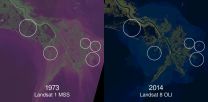Childhood physical and sexual abuse linked to ulcerative colitis
2015-08-06
(Press-News.org) TORONTO, ON - Adults who were exposed to childhood physical or sexual abuse were approximately twice as likely to have ulcerative colitis, according to a new nationally representative study from four researchers at the University of Toronto.
"We found that one-quarter of adults with ulcerative colitis reported they had been physically abused during their childhood, compared to one in 10 of those without inflammatory bowel disease," said the study's lead author, Professor Esme Fuller-Thomson, who holds the Sandra Rotman Endowed Chair at University of Toronto's Factor-Inwentash Faculty of Social Work. "Similarly, the prevalence of childhood sexual abuse among those with ulcerative colitis was one in five versus one in 17 among those without the disease."
Investigators examined a representative sample of 21,852 community-dwelling Canadians aged 18 and over from the 2012 Canadian Community Health Survey - Mental Health.
"The odds of ulcerative colitis were more than two times higher for those who reported that an adult had at least once kicked, bit, punched, choked, burned or physically attacked them before the age of 16," said Joanne Sulman, study co-author and adjunct lecturer at U of T. This is in comparison to those who had not been physically mistreated.
"Occurrences of ulcerative colitis were also more than twice as high in individuals who reported that during their childhood an adult had forced them or attempted to force them into any unwanted sexual activity, by threatening them, holding them down or hurting them, in comparison to those who had not been sexually abused," said Sulman. "These strong associations remained even after we took into account sociodemographic characteristics, mental health conditions and health behaviours."
The study was published online in the journal Inflammatory Bowel Diseases.
"In contrast to the strong association between childhood maltreatment and ulcerative colitis, we found no association between either type of abuse and Crohn's disease," said Keri West, a master's student at U of T and study co-author. "This was very surprising because Crohn's disease and ulcerative colitis are two forms of inflammatory bowel disease and we expected that similar links would be apparent for the two disorders," We do not know why these differences exist but it's possible that epigenetics plays a role."
Both ulcerative colitis and Crohn's disease are debilitating immune-mediated chronic inflammatory disorders of the gastrointestinal tract. In North America, Crohn's disease affects 319 of every 100,000 people, while ulcerative colitis affects 249 out of 100,000 people.
"This research was based on a cross-sectional survey and therefore we cannot determine a cause and effect relationship, said co-author Stephanie Baird. "However, with such a high proportion of subjects with ulcerative colitis reporting childhood maltreatment, future research is clearing warranted."
INFORMATION:
ELSE PRESS RELEASES FROM THIS DATE:
2015-08-06
Rio de Janeiro -It could be a plot for a vampire story: In the middle of the night, blood-sucking creatures feed on peoples' faces and spread a deadly disease to the hearts of millions, who are then fated to endure a painful death.
Unfortunately, the excerpt is not science fiction, and dramatically illustrates what happens to millions of people who suffer, and eventually die from, chagasic heart failure.
Chagas Disease, also known as American trypanosomiasis, is caused by the parasite Trypanosoma cruzi and is spread by triatomine bugs, also called "kissing bugs". ...
2015-08-06
TORONTO - While recently published parenting books have preached the effectiveness of positive parenting and "no drama" discipline, psychologists presenting at the American Psychological Association's 123rd Annual Convention said don't put timeout in timeout yet.
"Parental discipline and positive parenting techniques are often polarized in popular parenting resources and in parenting research conclusions," presenter and researcher Robert Larzelere, PhD, of Oklahoma State University, said at a symposium. "But scientifically supported parenting interventions for young defiant ...
2015-08-06
Rabbits have long been considered immune to prion disease, but recently scientists have shown that they can--under certain circumstances--get transmissible spongiform encephalopathy (or TSE, the scientific term for the fatal brain disease caused by prions). Two studies published on August 6th in PLOS Pathogens address what makes rabbits hard to infect with prions and how their resistance can be overcome.
Prions are misfolded versions of a protein that, in its normal form (called PrPC, encoded by the PRNP gene), is found mainly in nerve cells of all mammals. The misfolded ...
2015-08-06
This news release is available in Japanese.
Today, many wealthy countries are able to mitigate, to some degree, their risk of delta flooding through vulnerability-reducing investments, but a new model suggests that this mitigation may not be sustainable in the long-term. Ultimately, wealthy countries could be feeling the strain of floods to a similar degree as developing countries. To calculate a given delta population's risk of flooding, Zachary Tessler and colleagues accounted for the population's probability of a damage-producing event, how the population's exposure ...
2015-08-06
This news release is available in Japanese.
As a devastating earthquake ruptured Nepal on April 25, 2015, nearby GPS networks continuously recorded measurements at very close distances. In a new study, these data provide the scientific community with unique insights into megathrust earthquakes, which occur when two tectonic plates converge and one plate is forced underneath the other, and may help hazard assessment teams improve earthquake hazard models. To better understand the sudden and intense changes megathrust earthquakes entail, John Galetzka et al. analyzed ...
2015-08-06
This news release is available in Japanese.
In the face of the recent Ebola outbreak, some good news emerges: a preclinical study testing the efficacy of the Ebola vaccine VSV-EBOV against the newly emerged West African Ebola strain shows complete protection when administered seven days before infection in nonhuman primates, and partial protection when administered three days before infection. The positive results of this study further reveal the mechanisms by which an effective immune response is mounted against the Ebola virus, aspects of which have been unclear. ...
2015-08-06
Darwinian selection can be used to evolve robot controllers able to efficiently self-organize their tasks. Taking inspiration from the way in which ants organise their work and divide up tasks, Eliseo Ferrante and colleagues evolved complex robot behaviors using artificial evolution and detailed robotics simulations.
Just like social insects such as ants, bees or termites teams of robots display a self-organized division of labor in which the different robots automatically specialized into carrying out different subtasks in the group, says new research publishing in PLOS ...
2015-08-06
Big data sets are important tools of modern science. Mining for correlations between millions of pieces of information can reveal vital relationships or predict future outcomes, such as risk factors for a disease or structures of new chemical compounds.
These mining operations are not without risk, however. Researchers can have a tough time telling when they have unearthed a nugget of truth, or what amounts to fool's gold: a correlation that seems to have predictive value but actually does not, as it results just from random chance.
A research team that bridges academia ...
2015-08-06
Autopsies of nearly every patient with the lethal neurodegenerative disorder amyotrophic lateral sclerosis (ALS), and many with frontotemporal dementia (FTD), show pathologists telltale clumps of a protein called TDP-43. Now, working with mouse and human cells, Johns Hopkins researchers report they have discovered the normal role of TDP-43 in cells and why its abnormal accumulation may cause disease.
In an article published Aug. 7 in Science, the researchers say TDP-43 is normally responsible for keeping unwanted stretches of the genetic material RNA, called cryptic ...
2015-08-06
For more than 20 years, Caltech geologist Jean-Philippe Avouac has collaborated with the Department of Mines and Geology of Nepal to study the Himalayas--the most active, above-water mountain range on Earth--to learn more about the processes that build mountains and trigger earthquakes. Over that period, he and his colleagues have installed a network of GPS stations in Nepal that allows them to monitor the way Earth's crust moves during and in between earthquakes. So when he heard on April 25 that a magnitude 7.8 earthquake had struck near Gorkha, Nepal, not far from Kathmandu, ...
LAST 30 PRESS RELEASES:
[Press-News.org] Childhood physical and sexual abuse linked to ulcerative colitis

